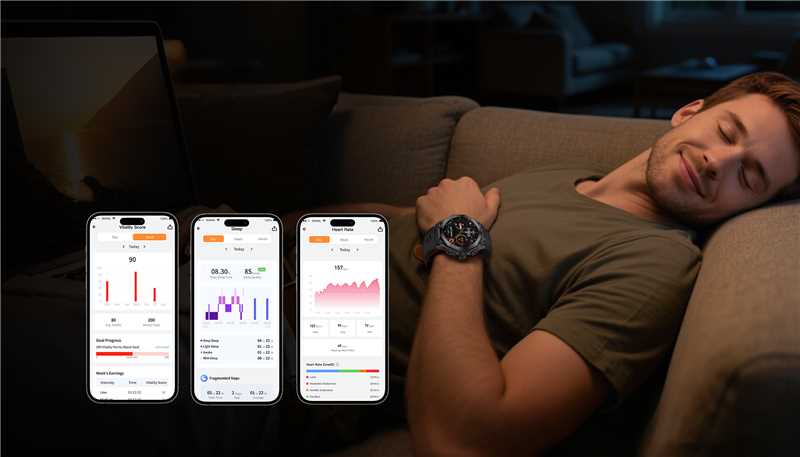

If you live for adrenaline, exploration, and pushing limits, the Trek1 Smartwatch was built for you. Whether you’re scaling rocky cliffs, blazing through forest trails, or camping under starlit skies, the Trek1 is your rugged, intelligent, and reliable companion.
But what truly sets this watch apart?
In this in-depth look, we’re breaking down the tech specs, powerful features, and real-world performance that make Trek1 one of the smartest pieces of outdoor gear you can wear. We’ll explore its GPS accuracy, PAI health tracking, AI-powered recognition, and battery life.
🌍 Built for the Wild, Powered by Tech
For outdoor athletes, explorers, and adventurers, the Trek1 smartwatch is a tool that is ready for any task and goes beyond simple wearable technology. It is made to withstand everything from rainy hikes to desert marathons thanks to its zinc alloy case, Panda tempered glass, and 5ATM water resistance.
Let us take a closer look at what makes Trek1 unique among smart outdoor devices.
📍 Standalone GPS: Navigate Without Limits
Using the integrated GPS, barometer, altimeter, and compass on the Trek1 eliminates the possibility of getting lost. Trek1 provides true standalone navigation, which keeps you on course even in the event of a cell service outage, in contrast to smartwatches that need to be paired with a phone.
Trek1 guarantees real-time GPS accuracy even in the deepest valleys or thickest jungles, whether you are geotagging campsites or following a cycling route.
💓 PAI Health Tracking: Beyond Steps and Stats
Forget about simple step counters. The Trek1 provides you with an accurate, scientifically supported picture of your heart health through the use of Personal Activity Intelligence (PAI). When used in conjunction with real-time heart rate, SpO₂ tracking, and sleep monitoring, it gives you actionable insights based on your actual physical output.
Furthermore, monitoring your stress and sleep patterns will help you make the most of your rest and recovery in addition to your movement.
🧠 AI-Powered Recognition: A Smarter Watch
Why would you want a smartwatch that can not keep up?
With the use of AI-powered recognition, Trek1 tracks and automatically recognizes over ten exercise modes, such as yoga, football, cycling, and trekking. It also adjusts to your preferences and habits, providing direct music/call control from your wrist, weather updates, and intelligent reminders.
Even better is the ability to take amazing pictures hands-free with a remote photography control.
🔋 Long-Lasting Battery Life: Go Farther
A smartwatch isn’t truly smart if it dies mid-hike.
The Trek1's 450mAh battery can last up to 14 days between charges, and it can last even longer when in power-saving mode. With wireless charging and a long-lasting battery, you can spend more time exploring and less time plugged in.
Interested in being featured?
Join our expanding international community of adventurers by tagging your photos with #MyTrek1!
📦 What’s in the Box?
Your Trek1 Smartwatch arrives ready for action with:
✅ Trek1 Smartwatch (1.43" AMOLED, 466×466 resolution)
✅ 1x Additional Silicone Strap
✅ Magnetic Wireless Charger
✅ User Manual
💌 Stay Connected
Want more first looks, fitness guides, and adventure inspiration?
🎯 Sign up for our newsletter to join the Trek1 tribe and get exclusive offers.
Ready to get yours?
🛒 Order the Trek1 Smartwatch now (Order now) and start your next chapter of wild, fearless living.
🎥 Coming Soon: #Trek1FirstImpressions
We’re launching a community campaign to highlight real unboxings, first impressions, and outdoor tests. Want to be featured?
Post your unboxing or first hike with Trek1 using #Trek1FirstImpressions and tag @aurafit.official for a chance to be reposted!
Trek1 Smartwatch
Live Bold. Move Smart. Explore Free.
✅ In short:
The IP68 rating is a standardized ingress protection code defined by the International Electrotechnical Commission (IEC). Here’s what it means:
However, note that IP68 is tested in lab conditions using still, fresh water. Real-world factors like water pressure, movement, temperature, and contaminants (e.g., salt or soap) can affect performance. For example:
While IP68 is robust, it may not cover all extreme scenarios:
Based on your needs:
IP68 is sufficient for hiking and heavy rain, as it protects against dust, rain, and accidental submersion. However, if your activities include swimming, diving, or high-pressure water exposure, opt for a watch with a 5ATM or higher rating. Always check the manufacturer’s guidelines to ensure longevity.
✅ Rule of thumb:
A rugged smartwatch should comfortably last at least 1–2 weeks per charge in normal use, and multiple days in GPS mode. Anything less and it’s closer to a “regular” smartwatch in disguise.
👉 If you wear it with a suit, a regular smartwatch or hybrid might look more polished. But for casual/sporty styles, rugged watches are increasingly versatile.
👉 Most rugged smartwatches are now comfortable enough for all-day wear, but if you have a smaller wrist, you may notice the bulk compared to a slim, regular smartwatch.
Share:
Why Choose AuraFit for Your Next Adventure?
The Ultimate Smartwatch Buying Guide for Fall 2025